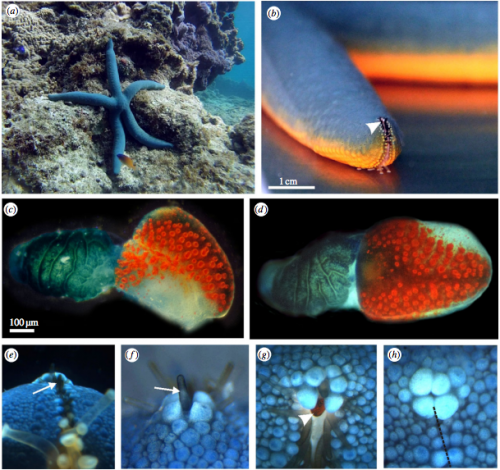January 8, 2014 report
Starfish use their eyes to stay close to home, researchers find

(Phys.org) —A starfish has an eye at the end of each arm. While scientists have known about the existence of these eyes for about two hundred years, until now, they haven't been able to find out what starfish can see or what starfish use their eyes for. By performing morphological studies as well as behavioral experiments, Anders Garm and Dan-Eric Nilsson have discovered that starfish can see very low resolution images, and they use their eyes to avoid straying too far from their habitats. Their research appears in the Proceedings of the Royal Society B.
While previous research has already shown that starfish can distinguish between light and dark, scientists haven't been sure if starfish can see images. Starfish don't have brains. While they have compound eyes, like arthropods do, starfish eyes, unlike arthropod eyes, don't have lenses. Previously, no one had ever seen a starfish use its eyes to navigate.
Garm and Nilsson examined the eyes of the blue sea star (Linckia laevigata), a starfish that lives around coral reefs in the tropical Pacific and Indian Oceans. The researchers found that these starfish cannot distinguish colors, and because their eyes lack lenses, they can see only very crude, low resolution images. Blue sea stars also have very slow responses to light. The sea stars could not use their eyes to evade predators, find food or search for mates.
Although starfish cannot detect small visual details, the placement of an eye on each arm gives them a large visual field. They can see large unmoving or slowly moving structures, such as the coral reefs that are their homes. Garm and Nilsson hypothesized that sea stars use their eyes to avoid straying too far from their coral reefs and becoming stranded on patches of sand, where they would be unable to find food and have no protection from predation. The researchers noted that while starfish cannot see colors, the ocean would appear light to them, while coral reefs would appear dark.
To test their hypothesis, Garm and Nilsson placed starfish either one, two or four meters away from a coral reef. When they were one meter away, the starfish walked directly toward the reef. At four meters, they walked in random directions. Two meters, the distance at which the starfish would no longer be able to resolve the image of the reef, appeared to be the limit for successful navigation. The results were the same whether the reef was east-west facing or north-south facing. Blinded seas stars were lost even when they were only one meter away, and sighted ones couldn't find their way back when they were one meter away on a moonless night. These results indicated that the sea stars were using their eyes to guide them.
The researchers think the development of the ability to recognize habitats could have been one of the earliest stages in the evolution of vision.
More information: Visual navigation in starfish: first evidence for the use of vision and eyes in starfish, Published 8 January 2014 DOI: 10.1098/rspb.2013.3011
Abstract
Most known starfish species possess a compound eye at the tip of each arm, which, except for the lack of true optics, resembles an arthropod compound eye. Although these compound eyes have been known for about two centuries, no visually guided behaviour has ever been directly associated with their presence. There are indications that they are involved in negative phototaxis but this may also be governed by extraocular photoreceptors. Here, we show that the eyes of the coral-reef-associated starfish Linckia laevigata are slow and colour blind. The eyes are capable of true image formation although with low spatial resolution. Further, our behavioural experiments reveal that only specimens with intact eyes can navigate back to their reef habitat when displaced, demonstrating that this is a visually guided behaviour. This is, to our knowledge, the first report of a function of starfish compound eyes. We also show that the spectral sensitivity optimizes the contrast between the reef and the open ocean. Our results provide an example of an eye supporting only low-resolution vision, which is believed to be an essential stage in eye evolution, preceding the high-resolution vision required for detecting prey, predators and conspecifics.
Journal information: Proceedings of the Royal Society B
© 2014 Phys.org





















